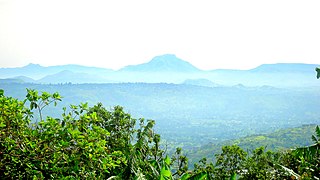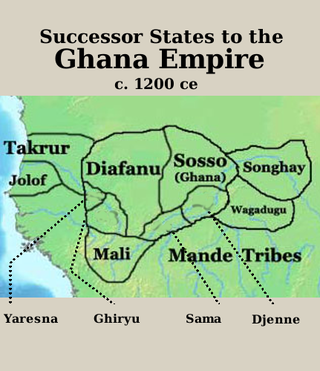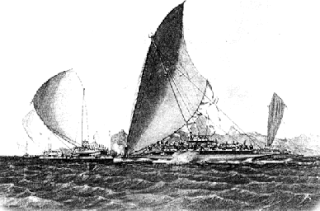Related Research Articles

The Mali Empire was an empire in West Africa from c. 1226 to 1670. The empire was founded by Sundiata Keita and became renowned for the wealth of its rulers, especially Mansa Musa. At its peak, Mali was the largest empire in West Africa, widely influencing the culture of the region through the spread of its language, laws, and customs.

The Mandinka or Malinke are a West African ethnic group primarily found in southern Mali, The Gambia, southern Senegal and eastern Guinea. Numbering about 11 million, they are the largest subgroup of the Mandé peoples and one of the largest ethnic-linguistic groups in Africa. They speak the Manding languages in the Mande language family, which are a lingua franca in much of West Africa. Virtually all of Mandinka people are adherent to Islam, mostly based on the Maliki jurisprudence. They are predominantly subsistence farmers and live in rural villages. Their largest urban center is Bamako, the capital of Mali.
Sundiata Keita was a prince and founder of the Mali Empire. He was also the great-uncle of the Malian ruler Mansa Musa, who is usually regarded as the wealthiest person of all time, although there are no reliable ways to accurately calculate his wealth.
Naré Maghann Konaté was a 12th-century faama (king) of the Mandinka people, in what is today Mali and the progenitor of the Maghan people of Ghana. He was the father of Sundiata Keita, founder of the Mali Empire, and a character in the oral tradition of the Epic of Sundiata.
The Battle of Kirina, also known as the Battle of Krina or siege of Karina, was a confrontation between Sosso king Sumanguru Kanté and Mandinka prince Sundiata Keita. Sundiata Keita's forces roundly defeated those of Sumanguru Kanté, guaranteeing the pre-eminence of Keita's new Mali Empire over West Africa.
Sunjata is an epic poem of the Malinke people that tells the story of the hero Sundiata Keita, the founder of the Mali Empire. The epic is an instance of oral tradition, going back to the 13th century and narrated by generations of jelis (griots). There is no single or authoritative version. Material pertaining to the epic first began to be collected during the early 20th century in French Sudan, notably by the French elite school École William Ponty, resulting in the "modern" version of the tale as considered standard today, based on the oral account by Djeli Mamoudou Kouyate, a jeli or traditional oral historian, translated into French by Djibril Tamsir Niane in 1960.

Mamady Keïta was a drummer from the West African nation of Guinea. He specialized in the djembe. He was also the founder of the Tam Tam Mandingue school of drumming. He was a member of the Manding ethnic group.

Bandjoun is a town and commune in the Koung-Khi Department in the West Region of Cameroon. Bandjoun is also the capital of the Koung-Khi department, and one of the largest traditional chefferie (chiefdom) in Bamiléké country. The chief dwells in Hialah, and has many wives.

Siby is a village and rural commune in the Cercle of Kati in the Koulikoro Region of southern Mali. The commune contains 21 villages and in the 2009 census had a population of 26,632. The village lies 50 km southwest of the capital, Bamako, on the plain to the south of the Monts Mandingues. The RN5 road that links Bamako with Siguiri in Guinea runs through the village.

Kouroukan Fouga, or Kurukan Fuga, was the constitution of the Mali Empire created after the Battle of Krina (1235) by an assembly of nobles to create a government for the newly established empire, according to the Epic of Sundiata. According to oral tradition of the jelis of Mali and Guinea, the Kouroukan Fouga established the federation of Mandinka clans under one government, outlined how it would operate and established the laws by which the people would live. The name Kurukan Fuga is a toponym, translating to "clearing on granite/lateritic rock", referring to the plain near where the narrative has Sundiata Keita present the charter. This is often claimed to have been near the town of Ka-ba, following the interpretation of Djibril Tamsir Niane, but other scholars have argued that oral histories more commonly place the event at nearby Dakajalan.
The Kuranko, also called Koranko, Kolanko, Kooranko, Koronko, Kouranko, Kulanko, Kurako, Kuronko, Kuranké, or Karanko, are a Mandeka people that occupy a large section in a mountainous region within northeastern Sierra Leone and southern Guinea. Within this geographical region, different dialects, as well as distinct social groupings can be found. In general, the Koranko are a peaceful people who have maintained a separate ethnic identity, despite years of tribal mixings. Each Kuranko village is led by a chief and a group of elders.

Pre-imperial Mali refers to the period of history before the establishment of the Mali Empire, an African empire located mostly in present-day Mali, in c. 1235.

The Kissi people are a West African ethnolinguistic group. They are the fourth largest ethnic group in Guinea, making up 6.2% of the population. Kissi people are also found in Liberia and Sierra Leone. They speak the Kissi language, which belongs to the Mel branch of the Niger–Congo language family. The Kissi are well known for making baskets and weaving on vertical looms. In past times, they were also famous for their ironworking skills, as the country and its neighbors possessed rich iron deposits. Kissi smiths produced the famous "Kissi penny,"

The Lasakau Sea Warriors were a 19th-century warrior sub-culture in the pre-colonial state of Bau, in Fiji. The sea warriors were instrumental in spreading Bau's political power throughout the South Pacific archipelagic islands. The rise of the eminent islet of Bau amongst other embryonic states was due mainly to the projection of sea power through its naval forces. Bauan chief Ratu Loaloadravu Tubuanakoro was praised by French Captain Dumont D'Urville in May 1827 for his geographic knowledge of the Fijian archipelago signifying Bau's naval influence. More far-ranging than Bau's land warriors led by the Vusaradave clan, the Lasakau clan became the leading proponents of war and tribute for the emerging island kingdom. They became known as the Bai kei Bau or 'War fence of Bau'. Sahlins made the crucial observation that," The kings of Bau based their rule not on native cultivators but on native sailors and fishers-which is to say in Fijian categories, as in political strategies, not on the land but on the sea". This was the great political transformation that catapulted Bau to power over other pre-colonial kingdoms.
In the ancient African oral tradition of the Epic of Sundjata, Balla Fasséké is Sundiata Keita's jeli (griot). King Naré Maghann Konaté offered his son Sundiata a jeli, Balla Fasséké, to advise him in his reign. He would go on to serve as the ancestor of the Kouyate dynasty of Malinke griots.
Dankaran Touman was the first son of Naré Maghann Konaté in the Malian epic of Sundiata. He was also the King of Manden before the establishment of the Mali Empire.
Princess Mkabayi kaJama was a Zulu princess, the head of the Qulusi military kraal, and a regent of the Zulu Kingdom. She persuaded her father, the Zulu King Jama kaNdaba, to remarry, and acted as a regent during the reign of her half-brother, Senzangakhona.

Manding, Manden or even Mandé is a region located in West Africa, a space between southern Mali and eastern Guinea. It is the historic home of the Mandinka community.
Sogolon Wulen Condé of Dò ni Kiri, commonly known as Sogolon Condé, was a 13th-century princess of Imperial Mali, and one of the prominent women portrayed in the Epic of Sundiata. Her trials and tribulations are well preserved in the epic. She was the second wife of Faama (King) Naré Maghann Konaté, and mother of Mansa Sundiata Keita, founder of the Mali Empire in the 13th century. According to Bamba Suso and Banna Kanute, Sogolong's father was Sankarang Madiba Konte, also known as Faa Ganda, a descendant of Khulubu Konte. In the epic, Sogolon is portrayed as the daughter of the "buffalo woman" –so-called because of her "ugliness" and hunchback, and so was Sogolong. The griots of Guinea refer to Sogolon as the younger sister of Do Kamissa. In many parts of the Senegambia region, and Mali, Sogolon is regarded as her daughter. As well as her physical deformities and "ugliness", Sogolon also gave birth to a disabled son (Sundiata), and was ridiculed for that. Following the death of her husband Naré Maghann Konaté, her co-wife, the politically ambitious Sassouma Bereté, Naré Maghann's first wife along with their first son Dankaran Toumani Keïta, plotted against Sogolon and her children, including assassination attempts on their lives. Fearing that the new King Dankaran and his mother Sassouma could inflict harm upon her and her children, Sogolon went into exile with her children to protect them from harm. Due to the power and influence of Dankaran and his mother, Sogolon and her children were refused asylum by many states within the Ghana Empire they traversed seeking protection. She was eventually granted asylum by the King of Mema Mansa Farin Tunkara. In Mema, Sogolon encouraged his disabled son Sundiata to fulfill his destiny, and return to Mali (Manden) and take the throne.
The history of the Mali Empire begins when the first Mande people entered the Manding region during the period of the Ghana Empire. After its fall, the various tribes established independent chiefdoms. In the 12th century, these were briefly conquered by the Sosso Empire under Soumaoro Kante. He was in turn defeated by a Mande coalition led by Sundiata Keita, who founded the Mali Empire.